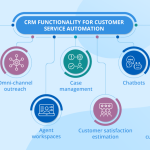“I can’t imagine my life without marketing automation. It’s a no brainer. To me, the fact that so many companies don’t have it is amazing.”
− Holly Condon, VP Business Development, Papersave
Marketing professionals more often than not tend to be a little unorganized when it comes to planning, designing, and implementing their marketing strategies. It may be due to approaching deadlines or near-to-impossible targets. With the help of marketing automation software, they can become more organized.
Marketing automation is the process that works as a supporting system for the marketers and marketing managers to achieve their work related objectives.
There are two components of marketing automation −
● Hardware − Computing devices (Computers, laptops, tablets, etc.), networking devices (modems, routers, firewalls, etc.)
● Software − The solution that offer smooth management of marketing practices.
Marketing Automation Software Applications
There are large number of marketing automation software applications available to date. Some of them are as follows −
● Asset management − It enables the business to identify and track the tangible or intangible assets the customers purchase, rent, license, or download.
● Campaign management − It enables businesses to plan, design, test, and implement a multichannel communication as well as track its progress and learn from its outcome. It also enables to create product awareness among customers, influence their behavior, and motivate them to purchase the product or visit the business website. This software provides the following key elements
○ Setting the workflow − It organizes the tasks with respect to their priorities.
○ Segmentation and Targeting − Entire customer base is divided into groups such that the marketers can serve each group in the best way.
○ Personalization − The messages and offers are customized individually.
○ Execution − The campaign can be executed simultaneously through multiple communication channels such as television, telephone, Email, mobile messages.
○ Measurement − It aids in measuring the success of the campaign. The outcomes are referred in future campaigns.
○ Reporting − Reports help to assess marketing efforts and progress.
● Customer Segmentation − This application categorizes the customers into relevant groups so that there are strong links between the members of the same groups and they are served to more customized offers.
● Direct mail campaign management − It involves sending offers to the customers by post. Though it is traditional way, it is still in practice.
● Email Campaign management − It enables sending offer Emails on permission of the customers. Email campaigns give insight of Click Through Rate (CTR) and conversion rate.
● Marketing Performance Management − It helps to evaluate the performance of campaigns, offers, marketing channels, marketing processes, and strategies. It helps to measure customer satisfaction, churn rate, and migration.
● Marketing Resource Management − It enables marketers to handle the resources, assets, and processes effectively. It includes modules for digital asset management, time management, event planning, etc.
● Document management − It ensures all marketing documents are safe, up-to-date and sharable among marketing staff when required.
● Reporting − This functionality enables periodic report generation for the purpose of assessment and tracking progress.
The other examples of marketing automation software are product lifecycle management, partner marketing, and telemarketing.
Benefits of Marketing Automation
The benefits of implementing marketing automation are −
● Enhanced marketing processes − More streamlined and cost-efficient processes, which can be followed by even a novice marketer.
● Greater reachability to audience − Hundreds and thousands advertises can be shown using multiple channels, which increases marketing productivity.
● Effective Closed Loop Marketing (CLM) − The marketing strategy that is based on “Plan-Implement-Assess-Learn and Change” stages is called closed loop marketing. MA ensures effective implementation of CLM.
● Improved marketing knowledge − Reporting facility increases marketer’s insight into customers, campaigns, market trends, etc.
● Increased customer experience − MA ensures sending no spam mails. On the contrary, it sends the customers only appropriate offers at right times.
● Instant response − Without being a part of annual campaign plan, the marketers can respond to an opportunity immediately.


